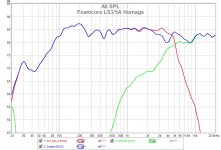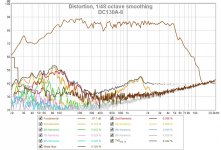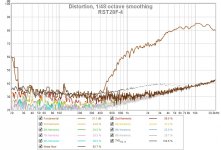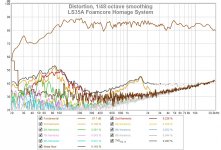This started as a curiosity for me in this thread on suitable replacement drivers for a small speaker similar to the LS5/3A. I decided to make a small sealed speaker of the same dimensions as the LS3/5A (12in tall x 7.5in wide x 6.5in deep) with a goal to reproduce the typical response that it so famous for - but using modest (inexpensive) and readily availble drivers. The Dayton RST28F-4 is a newer low cost but well built soft dome and the DC130A-8 is a coated paper 5.25in woofer that has a pretty smooth response.
Details on the construction of the speaker can be found here in the foamcore speaker thread. Basically 3/16in Elmer's brand foamcore sheets, doubled up on the baffle and braced. Noico mass loaded butyl damping applied om the inside aliong with melamine foam pads and grey eggcrate acoustic foam.
Here are some photos of the construction:
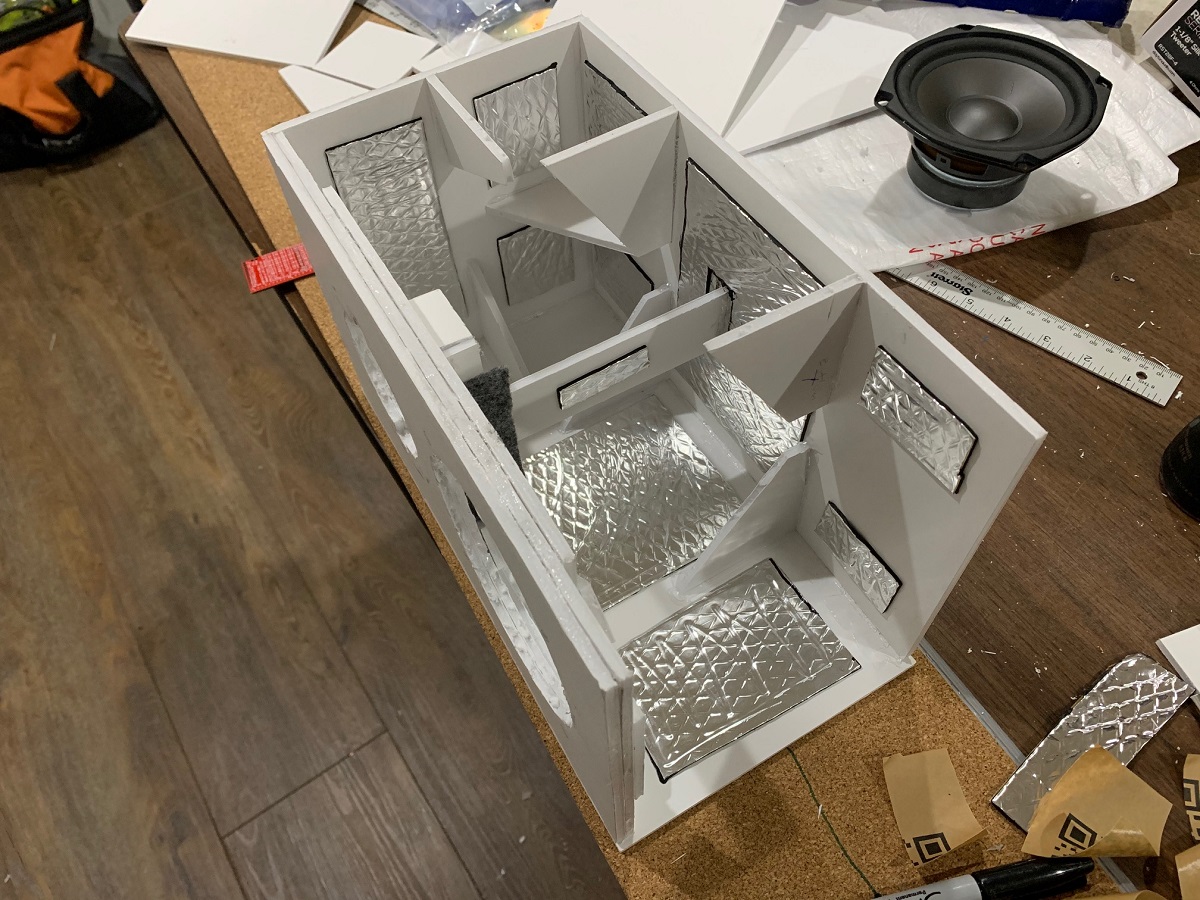
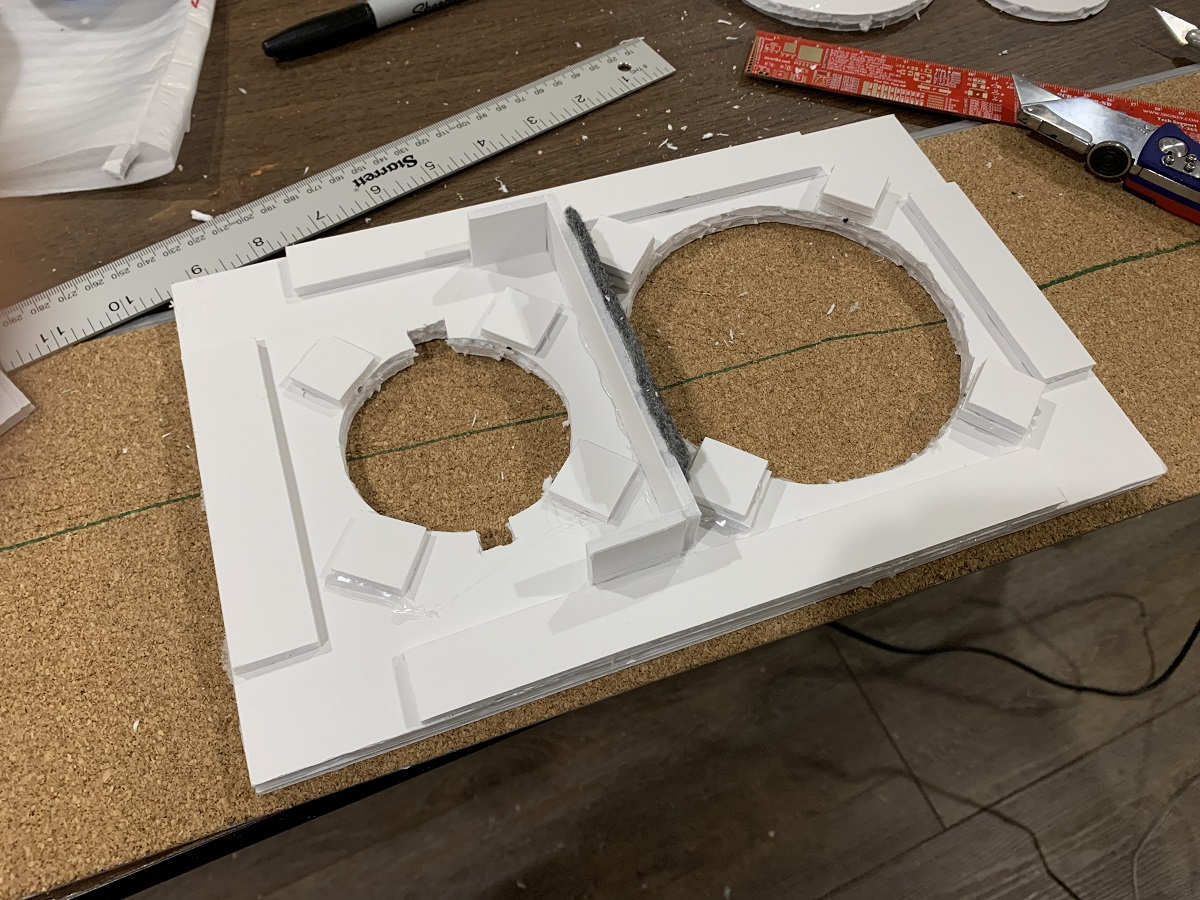
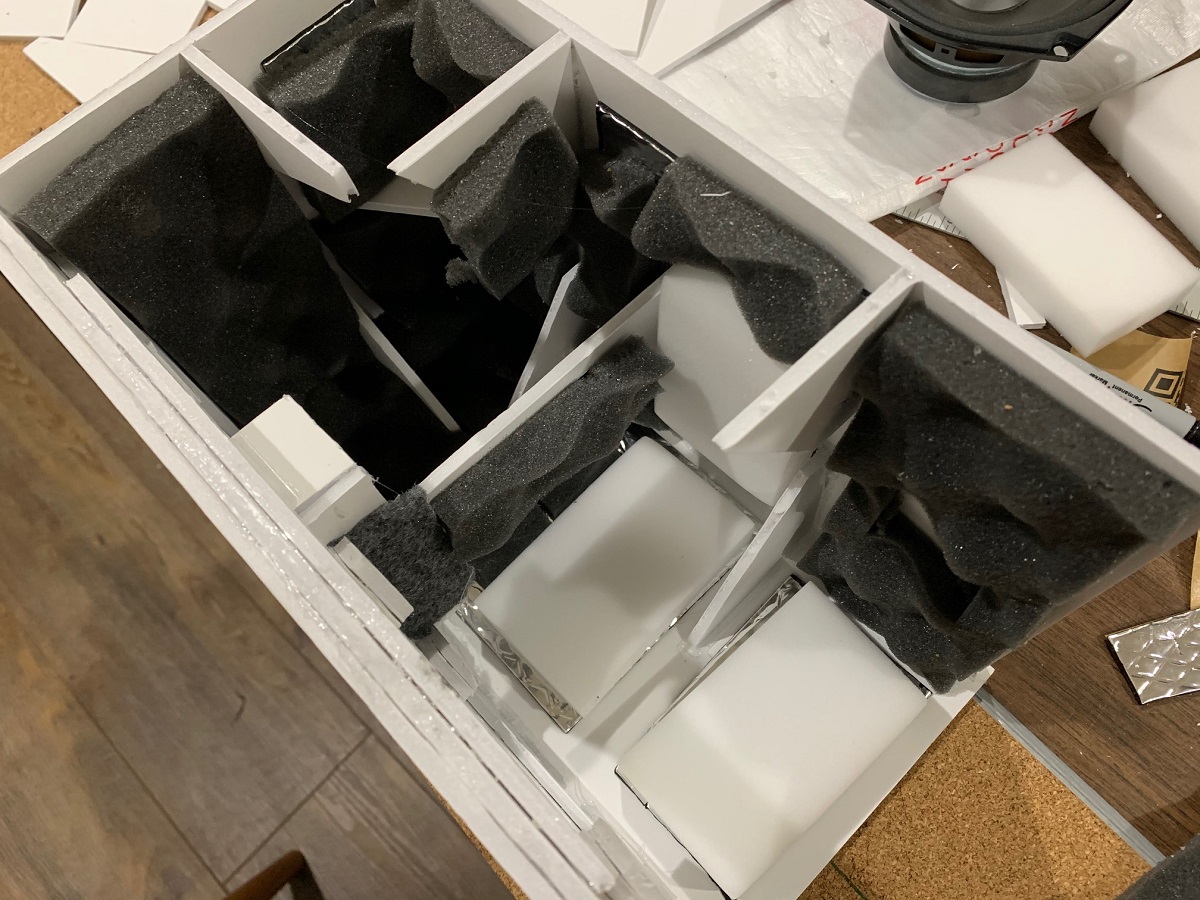
Here is the assembled speaker:
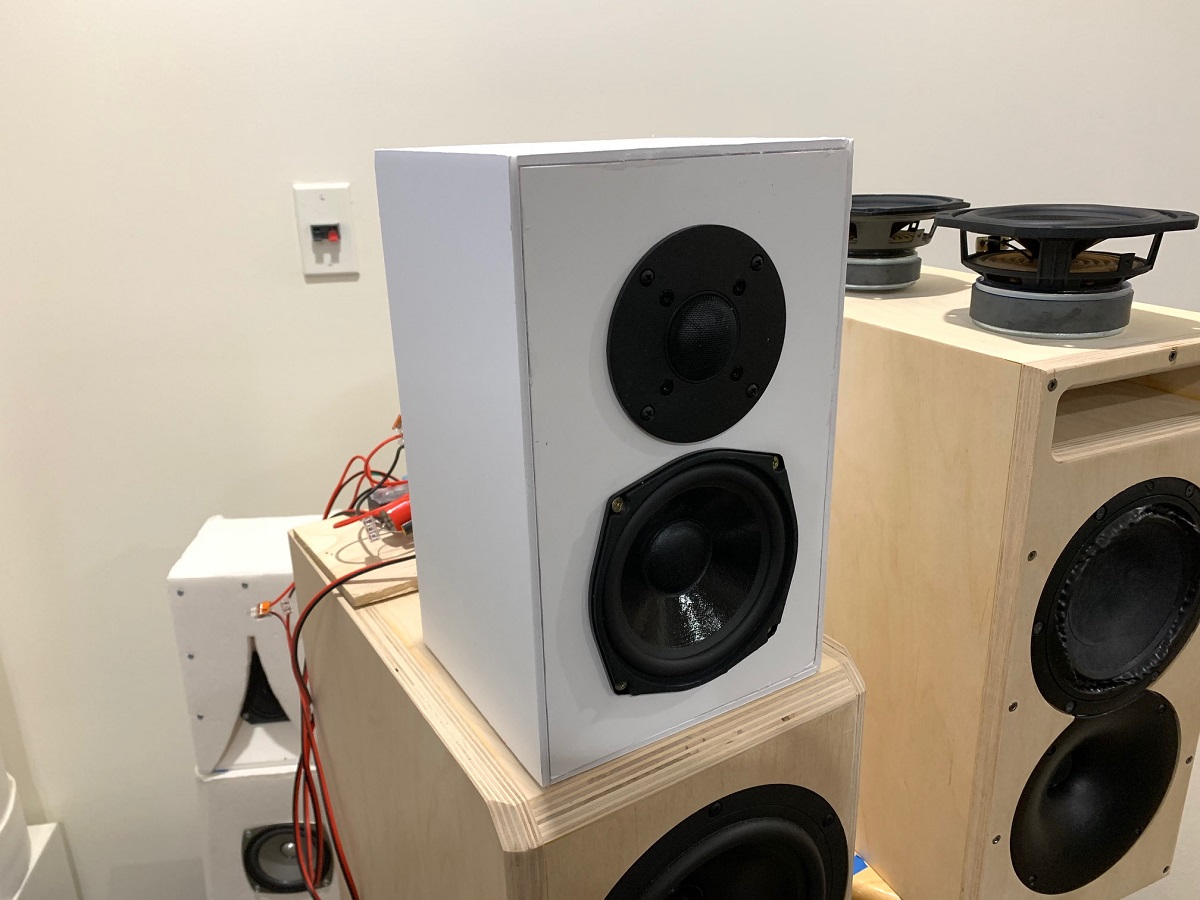
The measured raw responses of the drivers:
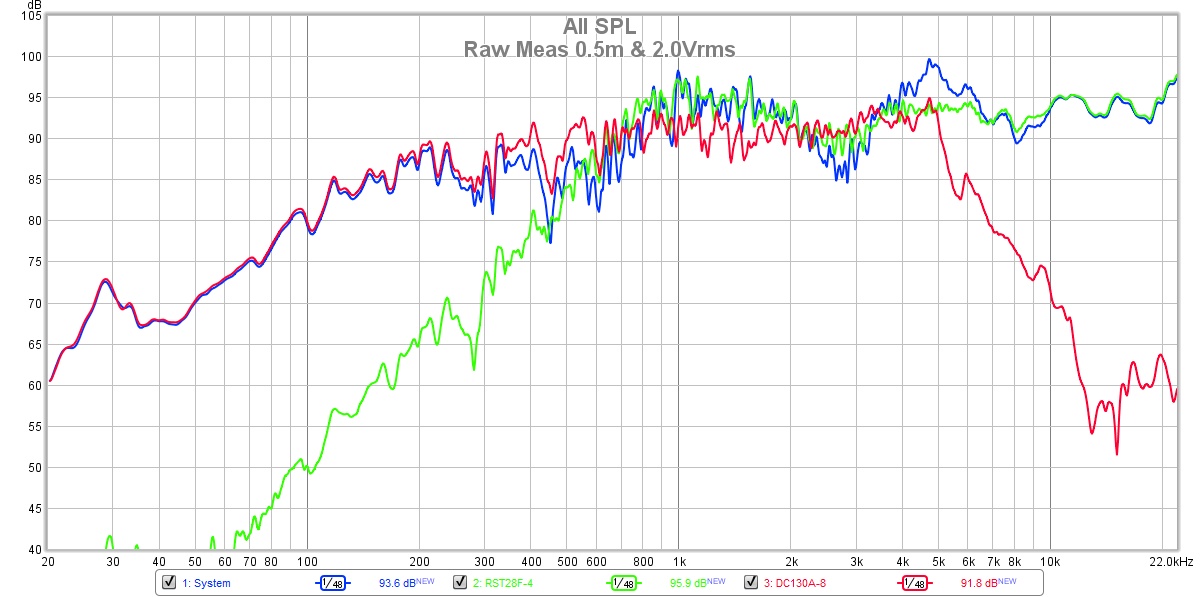
Here is first cut at the crossover (asymmetric Harsch-like with inverted tweeter):
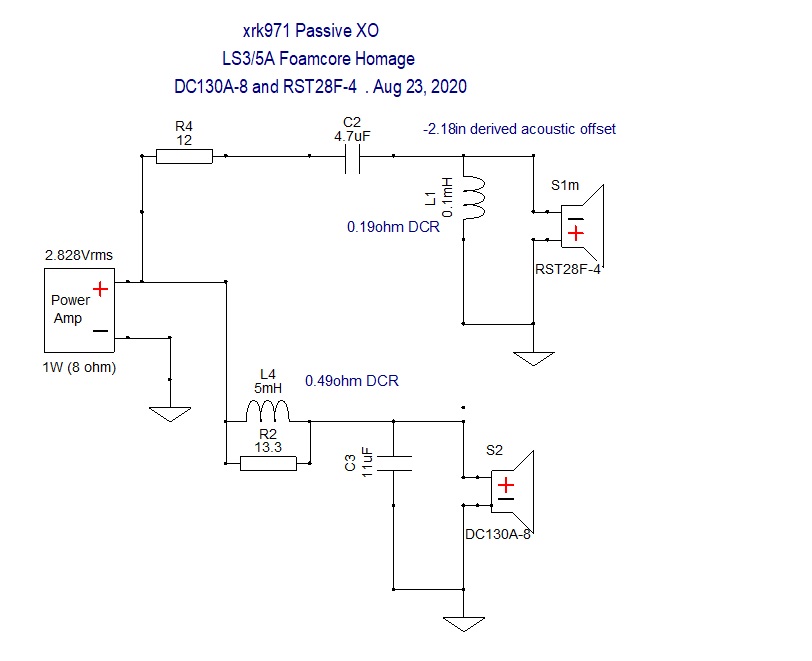
Here is the XO implemented outside with Wago connectors:
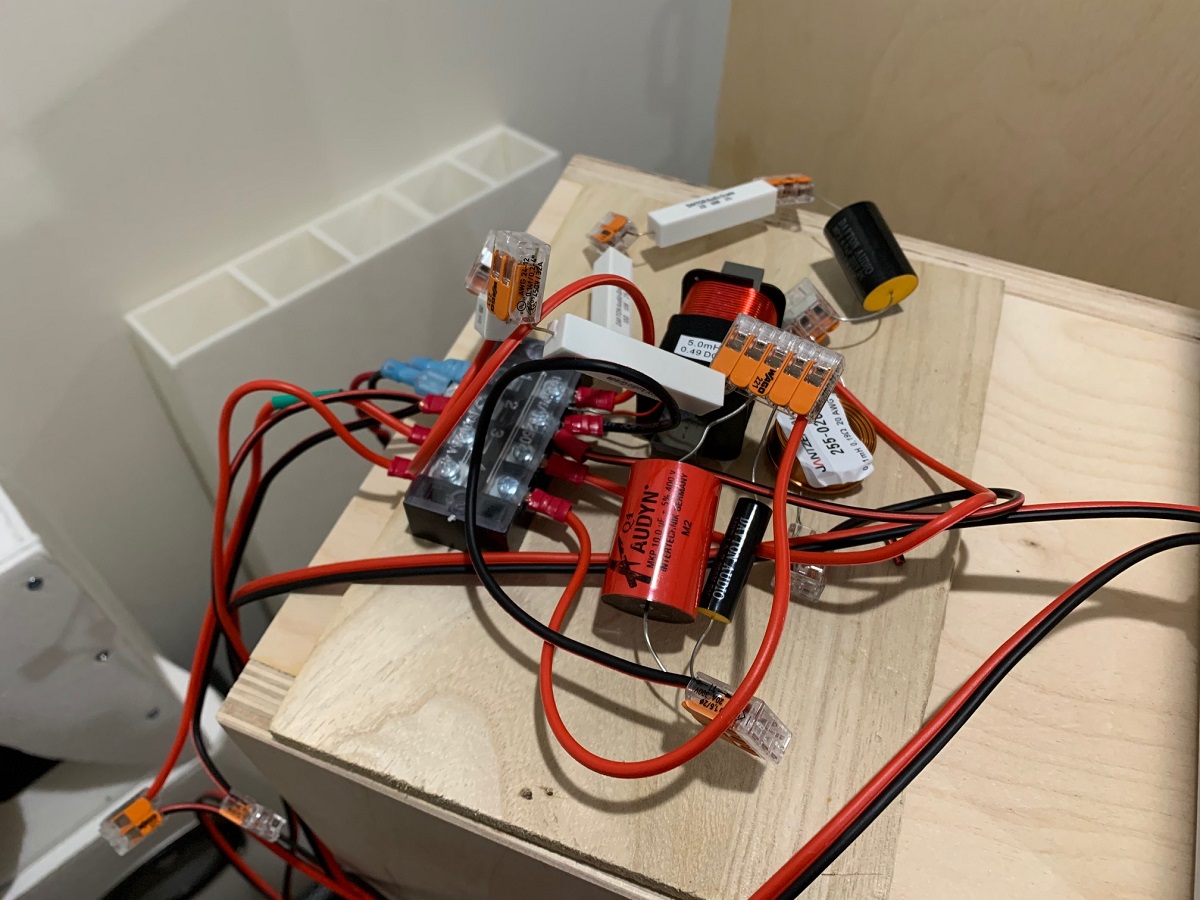
Here are the Crossover Part Numbers from Parts Express (per speaker)
L4 = 5mH 18ga #275-141 qnty 1
L1 = 0.1mH 20ga #257-568 qnty 1
C2 = 4.7uF MKP #255-020 qnty 1
C3A = 10uF MKP #027-114 qnty 1
C3B = 1uF MKP #027-410 qnty 1
R2A, R4 = 12.5ohm #006-12.5 qnty 2
R2B = 1.0ohm #006-027-101 qnty 1
C3 = C3A+C3B
R2 = R2A+R2B
Here is the predicted frequency response:
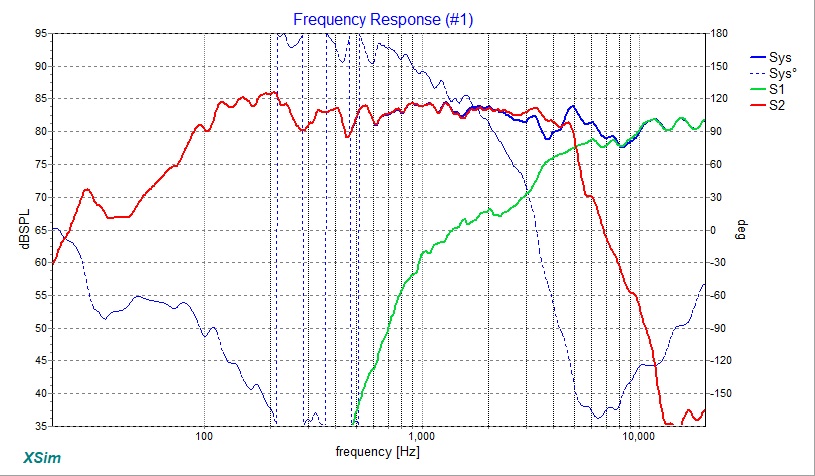
For comparison, here is the measured response of a typical LS3/5A:
Here is the predicted impedance - very benign and nominally 7 to 8ohms with a 22ohm peak at box tuning:
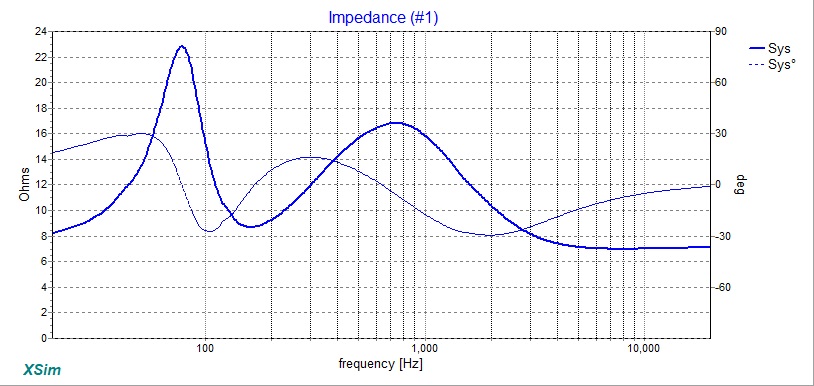
Here is the measured frequency response of the XO - note the wiggle in summed values around the XO - results from the asymmetric slopes in a Harsch-like approach:
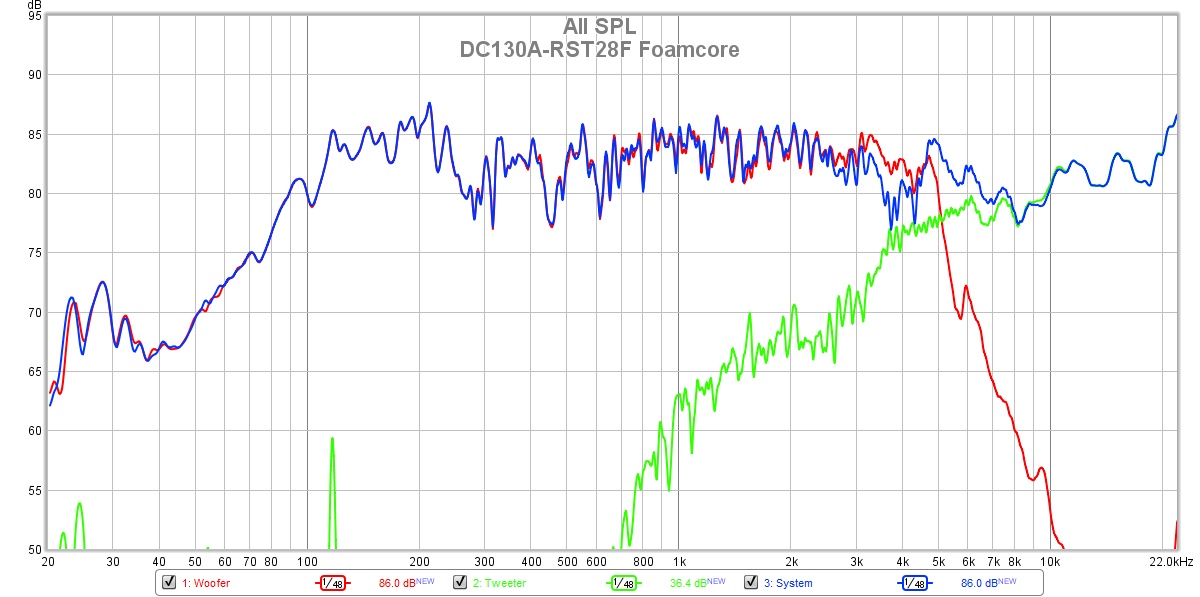
Edit 8/25/2020: I remeasured the freq response a few days later and applied 7cycle FDW to match closer the smoothing of the Stereophile data:
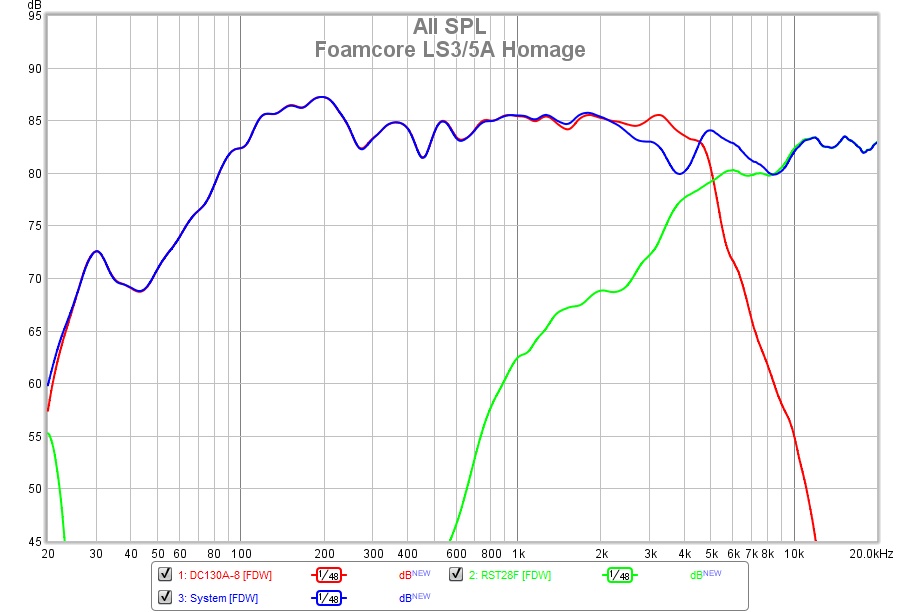
Here is the corresponding HD vs frequency at 0.5m and 2.0Vrms:
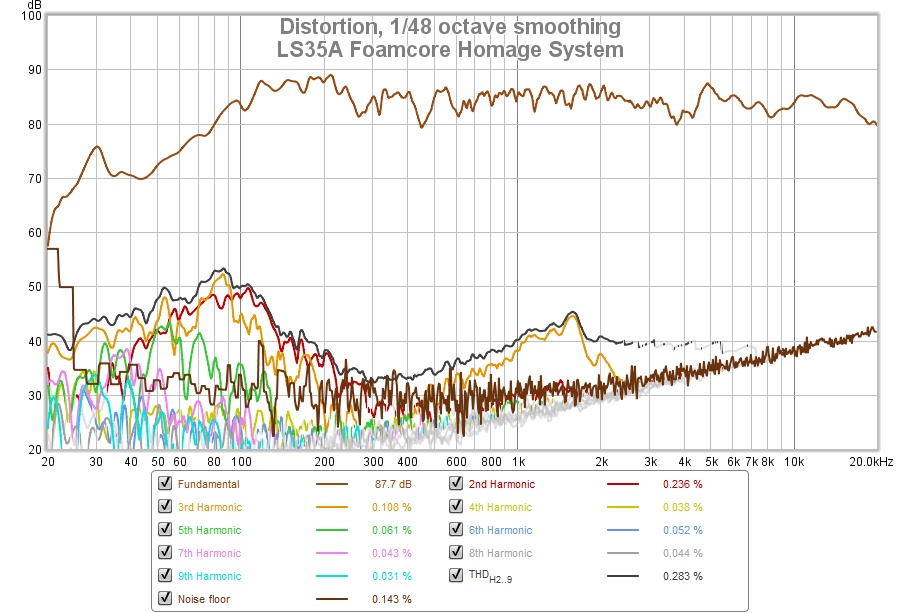
Here is the measured Step Response:

This is the measured system impedance with XO and inside the box:
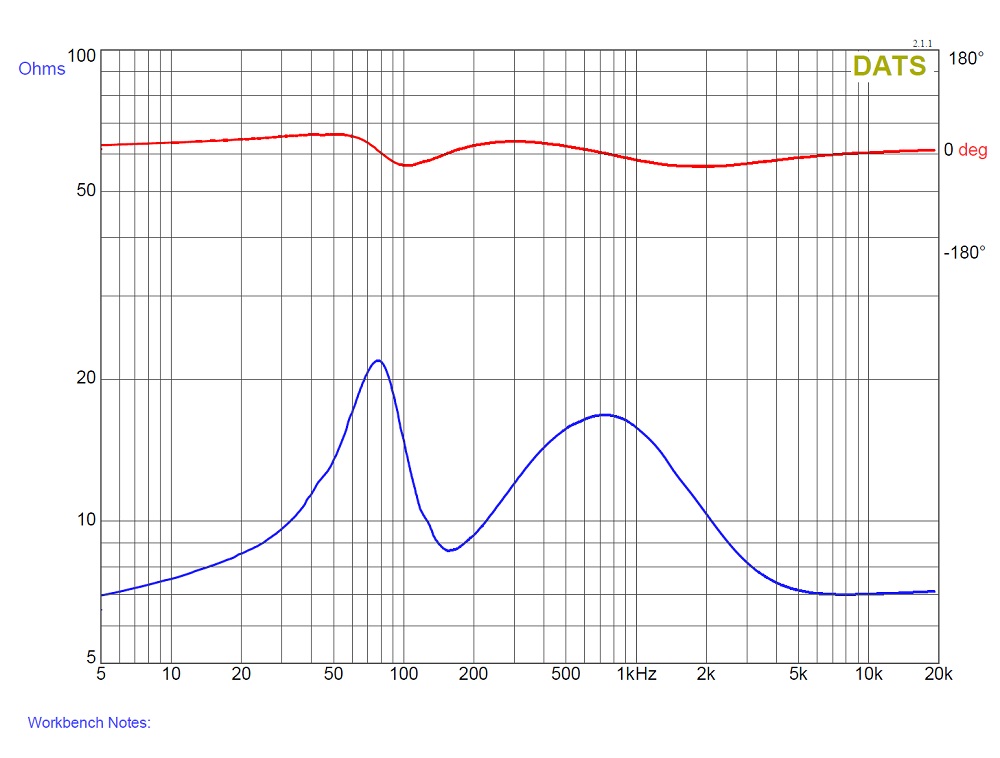
Edit Oct 11, 2020 - Polar (horiz) frequency response measurements at 0.5m and 2.0Vrms:
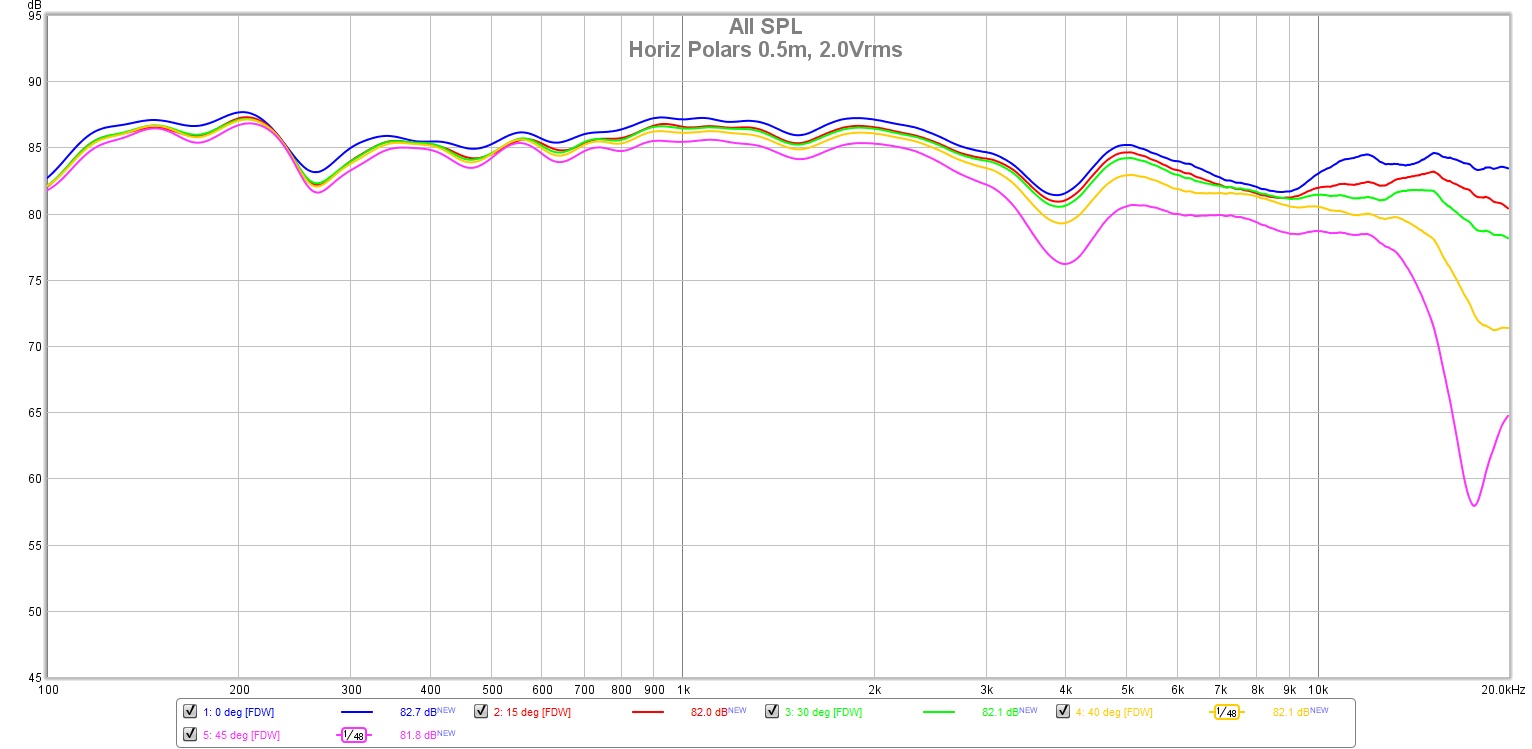
I am just atartitng to listen to it.. nice sounding and very clear vocals. Will give update later once I have more time. But not a bad compact bookshelf using basic components.
3D CAD plans for 9mm BB ply version with beech battens and 12mm baffle to allow for rebates for flush front mounted drivers:
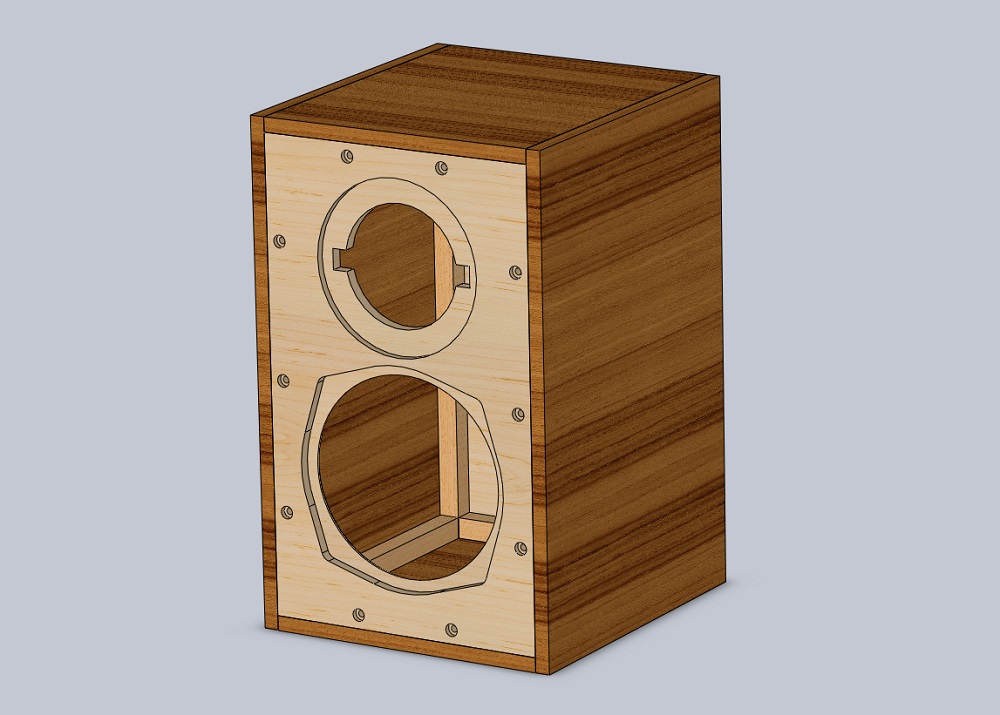
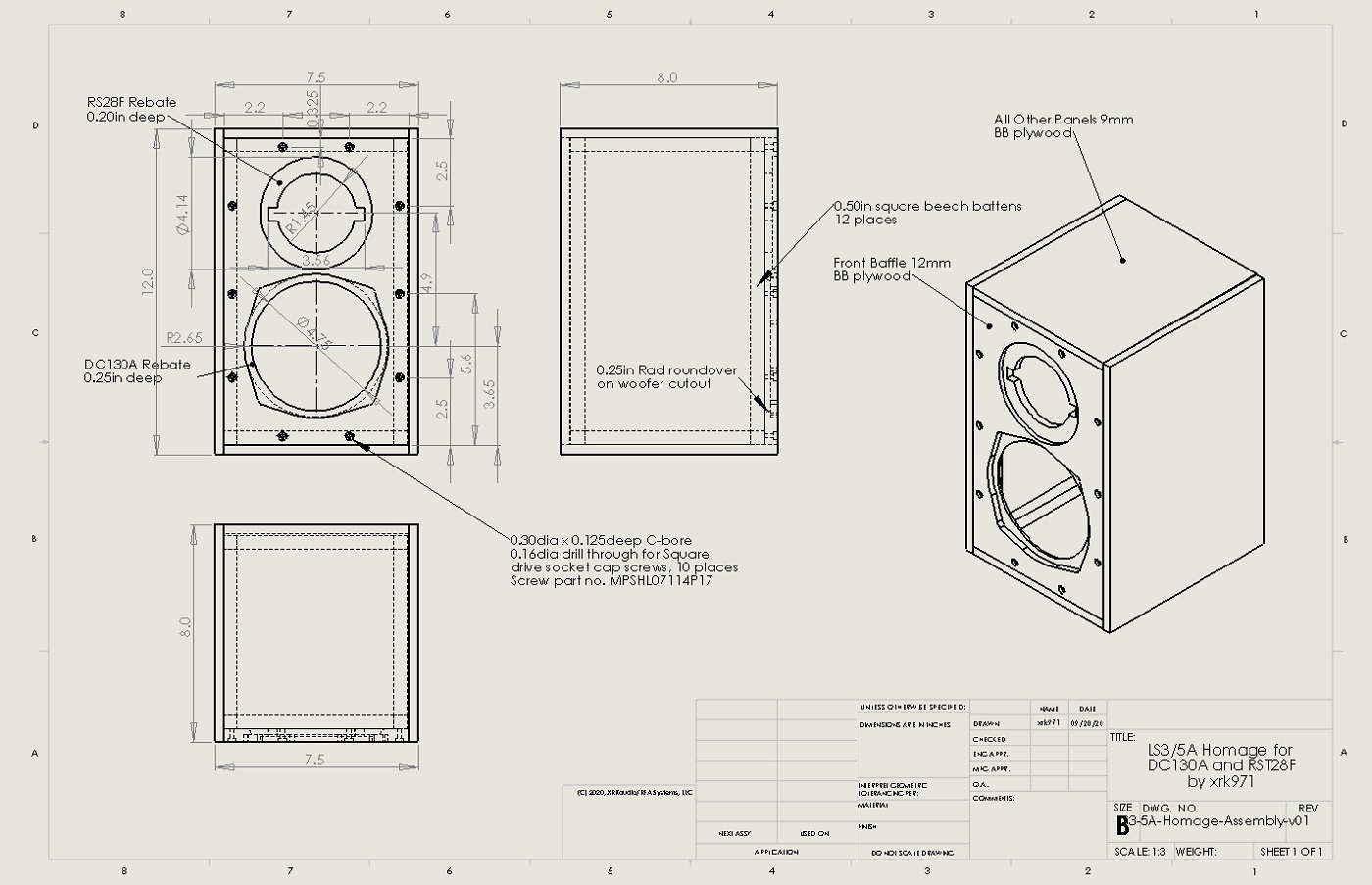
Edit Dev 5, 2020: wooden cabinets - called Rockville’s now finished and playing nicely. These speakers sound superb as near field monitors.
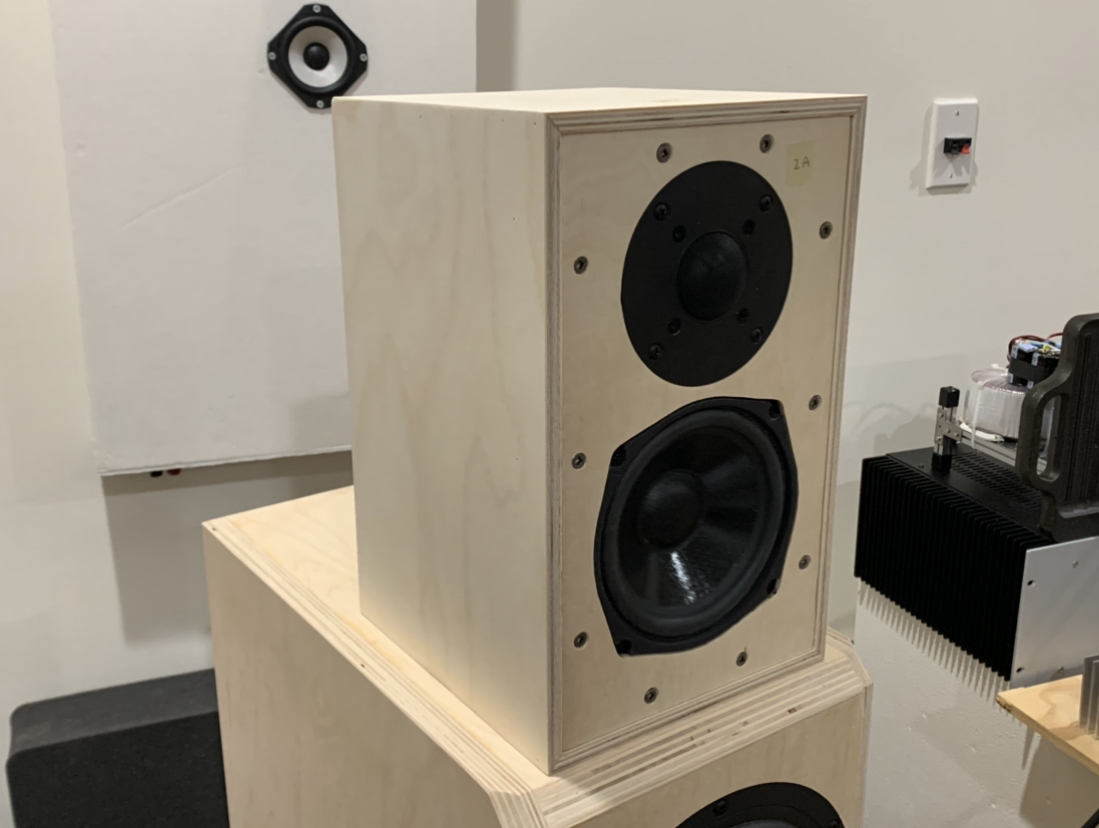
Crossover boards:
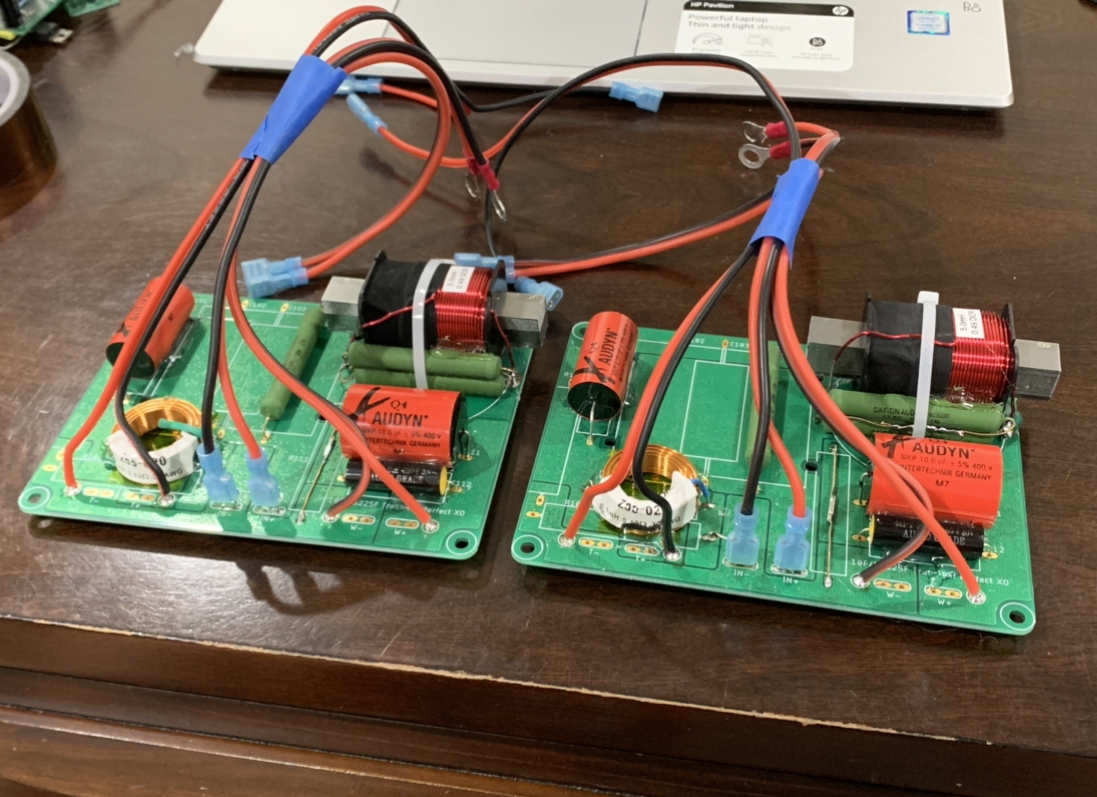
Back panel with name plate made (same as battens) from Civil War era white oak from a razed barn near Rockville Maryland.
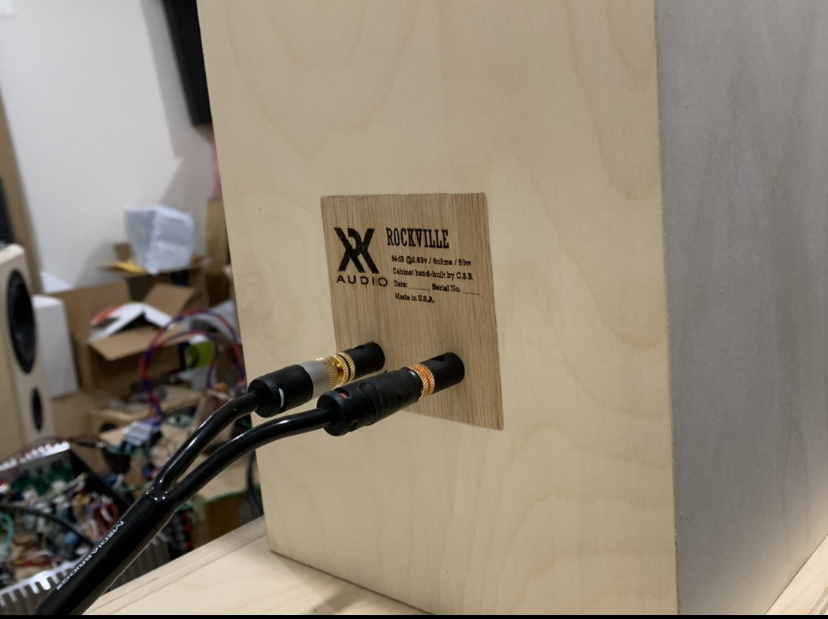
Details on the construction of the speaker can be found here in the foamcore speaker thread. Basically 3/16in Elmer's brand foamcore sheets, doubled up on the baffle and braced. Noico mass loaded butyl damping applied om the inside aliong with melamine foam pads and grey eggcrate acoustic foam.
Here are some photos of the construction:
Here is the assembled speaker:
The measured raw responses of the drivers:
Here is first cut at the crossover (asymmetric Harsch-like with inverted tweeter):
Here is the XO implemented outside with Wago connectors:
Here are the Crossover Part Numbers from Parts Express (per speaker)
L4 = 5mH 18ga #275-141 qnty 1
L1 = 0.1mH 20ga #257-568 qnty 1
C2 = 4.7uF MKP #255-020 qnty 1
C3A = 10uF MKP #027-114 qnty 1
C3B = 1uF MKP #027-410 qnty 1
R2A, R4 = 12.5ohm #006-12.5 qnty 2
R2B = 1.0ohm #006-027-101 qnty 1
C3 = C3A+C3B
R2 = R2A+R2B
Here is the predicted frequency response:
For comparison, here is the measured response of a typical LS3/5A:
An externally hosted image should be here but it was not working when we last tested it.
Here is the predicted impedance - very benign and nominally 7 to 8ohms with a 22ohm peak at box tuning:
Here is the measured frequency response of the XO - note the wiggle in summed values around the XO - results from the asymmetric slopes in a Harsch-like approach:
Edit 8/25/2020: I remeasured the freq response a few days later and applied 7cycle FDW to match closer the smoothing of the Stereophile data:
Here is the corresponding HD vs frequency at 0.5m and 2.0Vrms:
Here is the measured Step Response:
This is the measured system impedance with XO and inside the box:
Edit Oct 11, 2020 - Polar (horiz) frequency response measurements at 0.5m and 2.0Vrms:
I am just atartitng to listen to it.. nice sounding and very clear vocals. Will give update later once I have more time. But not a bad compact bookshelf using basic components.
3D CAD plans for 9mm BB ply version with beech battens and 12mm baffle to allow for rebates for flush front mounted drivers:
Edit Dev 5, 2020: wooden cabinets - called Rockville’s now finished and playing nicely. These speakers sound superb as near field monitors.
Crossover boards:
Back panel with name plate made (same as battens) from Civil War era white oak from a razed barn near Rockville Maryland.
Attachments
-
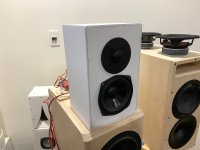 LS3-5A-foamcore-DC120A-RST28F-Build-photo.jpg205.4 KB · Views: 13,590
LS3-5A-foamcore-DC120A-RST28F-Build-photo.jpg205.4 KB · Views: 13,590 -
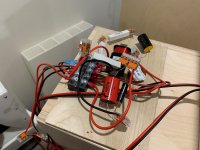 LS3-5A-foamcore-DC120A-RST28F-Build-Dev-XO-photo.jpg267.9 KB · Views: 8,734
LS3-5A-foamcore-DC120A-RST28F-Build-Dev-XO-photo.jpg267.9 KB · Views: 8,734 -
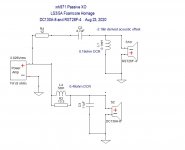 LS3-5A-Homage-DC130A-RST28F-XO-Schematic-v02.jpg65.5 KB · Views: 15,722
LS3-5A-Homage-DC130A-RST28F-XO-Schematic-v02.jpg65.5 KB · Views: 15,722 -
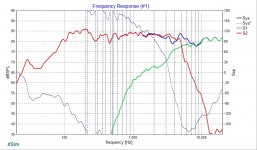 LS3-5A-Homage-DC130A-RST28F-XO-Predicted-Freq-v02.jpg154.6 KB · Views: 9,548
LS3-5A-Homage-DC130A-RST28F-XO-Predicted-Freq-v02.jpg154.6 KB · Views: 9,548 -
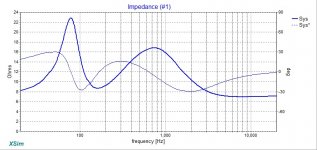 LS3-5A-Homage-DC130A-RST28F-XO-Predicted-Imped-v02.jpg114.7 KB · Views: 7,257
LS3-5A-Homage-DC130A-RST28F-XO-Predicted-Imped-v02.jpg114.7 KB · Views: 7,257 -
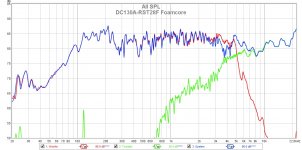 LS3-5A-Homage-DC130A-RST28F-Meas-Freq.jpg155.3 KB · Views: 7,162
LS3-5A-Homage-DC130A-RST28F-Meas-Freq.jpg155.3 KB · Views: 7,162 -
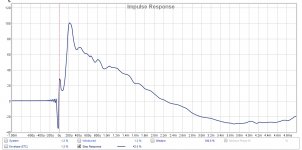 LS3-5A-Homage-DC130A-RST28F-Meas-Step-Resp.jpg121.5 KB · Views: 13,387
LS3-5A-Homage-DC130A-RST28F-Meas-Step-Resp.jpg121.5 KB · Views: 13,387 -
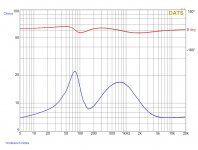 LS3-5A-Homage-DC130A-RST28F-XO-Meas-Imped-v02.jpg132.3 KB · Views: 12,060
LS3-5A-Homage-DC130A-RST28F-XO-Meas-Imped-v02.jpg132.3 KB · Views: 12,060 -
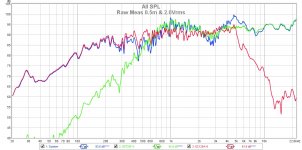 DC130A-RST28F-Raw-Meas.jpg165.8 KB · Views: 7,772
DC130A-RST28F-Raw-Meas.jpg165.8 KB · Views: 7,772
Last edited:
Thanks, Zman!
I just moved to speaker from the lab (4pi space on a stand) to an actual bookshelf in the bedroom. Wow, it sounds great! Real bass - now with wall boundary reinforcement it’s very enjoyable. The midrange is really smooth and clear. Super reaching highs too with the RST28F soft dome tweeter. I will build the stereo pair for sure now. You can tell when a speaker sounds great. It’s super.
I just moved to speaker from the lab (4pi space on a stand) to an actual bookshelf in the bedroom. Wow, it sounds great! Real bass - now with wall boundary reinforcement it’s very enjoyable. The midrange is really smooth and clear. Super reaching highs too with the RST28F soft dome tweeter. I will build the stereo pair for sure now. You can tell when a speaker sounds great. It’s super.
I was looking at this impedance plot more carefully and see that it mostly exists in the complex plane (varies) rather than a set DC value for the bulk of its range in the 100Hz to 5kHz where most of the music power resides. If I look at it over this range and use my eyeball to weight the impedance based on this range, I would say that the avverage impedance is closer to 11 to 12ohms - perhaps similar to the 11ohm or 15ohm spec of the LS5/3A? The lowest impedance is a realtively safe 7ohms. Your are not going to burn out any 8ohm tube amps with this design.

Another thought just occurred to me: the DC130A was actually the same driver I used in my compact PMC inspired TL speaker. It has the same diameter tweeter cutout and the RST28F could be dropped right in, with a simple switchover to this new XO for a speaker that has some serious bass capability.
Low-Cost PMC-inspired TL Monitor with DC130A and DC28F
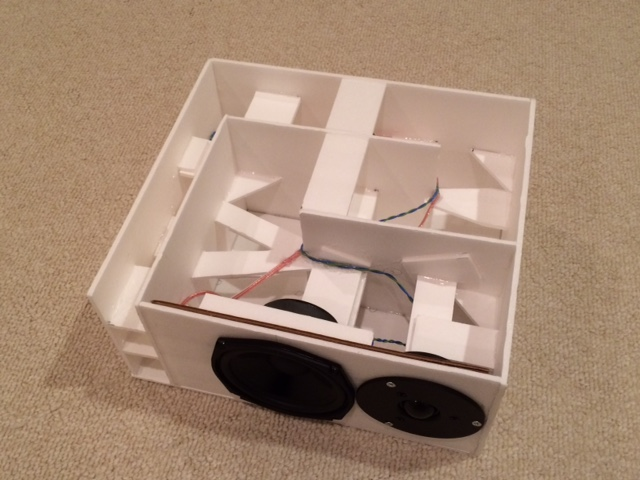
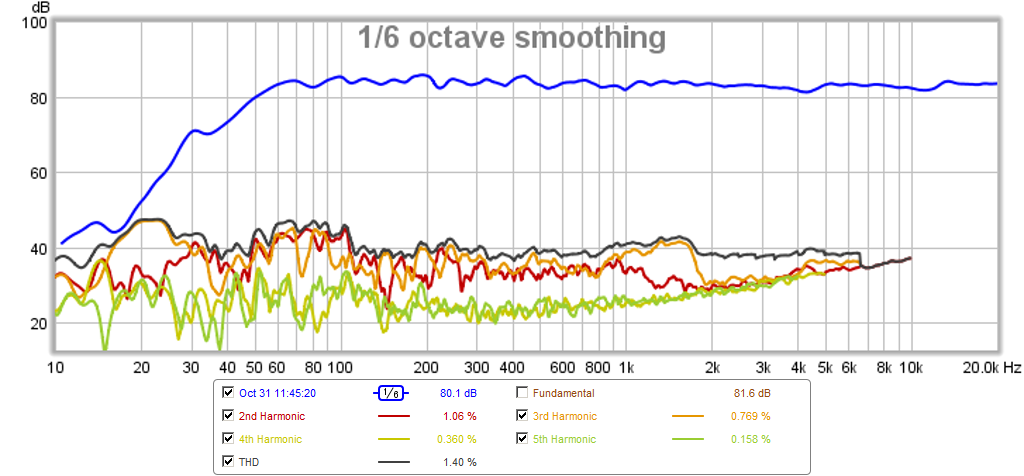
The raw woofer response looks familiar - except with real extension down to 50Hz or lower:
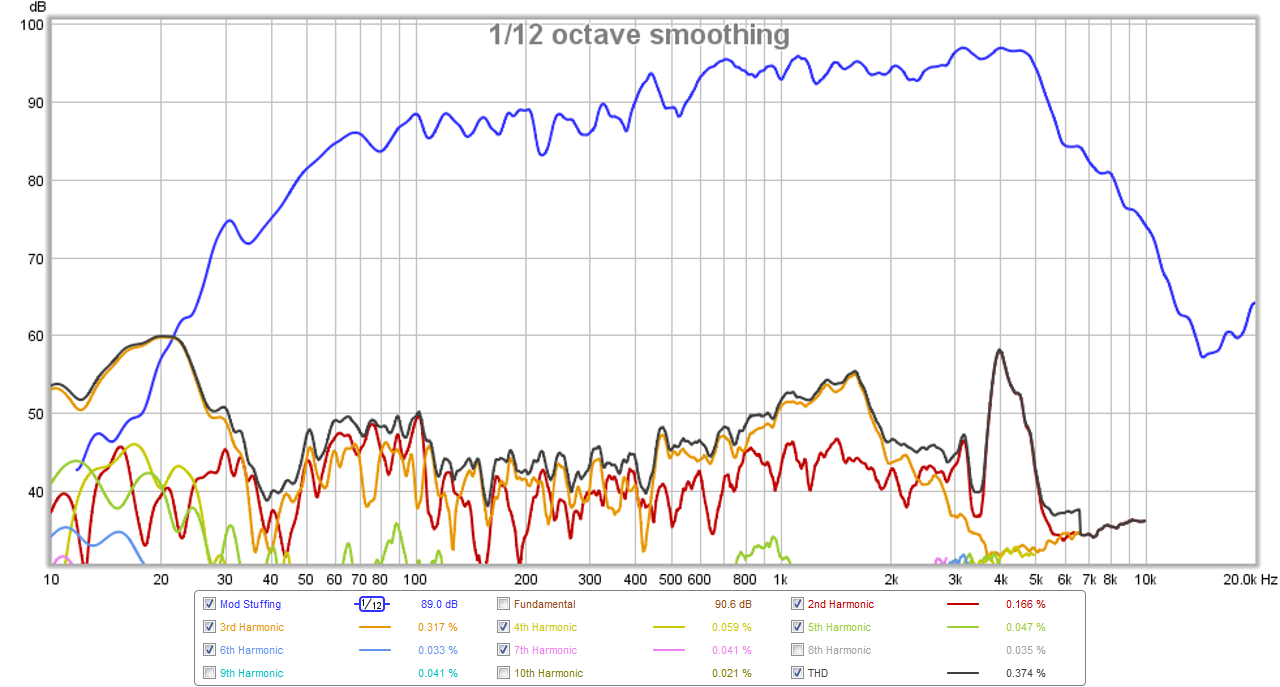
Another thought just occurred to me: the DC130A was actually the same driver I used in my compact PMC inspired TL speaker. It has the same diameter tweeter cutout and the RST28F could be dropped right in, with a simple switchover to this new XO for a speaker that has some serious bass capability.
Low-Cost PMC-inspired TL Monitor with DC130A and DC28F


The raw woofer response looks familiar - except with real extension down to 50Hz or lower:

Last edited:
The build in itself is nice, but without the typical BBC dip+ 3.5 kHz x/o mimicked in the design it is not even close to the the LS3/5A. The LS3/5A was not the only small speaker back in the day: KEF Caprice and Goodmans Maxim come to mind.
Correction: I now see you have a LS3/5A measurement as reference. It still looks a bit strange to me, not showing the BBC dip.
It depends on the year and manufacturer I guess. Here is Stereophile review of a Stirling which has the dip but when compared to 1978 Rogers or 1996 KEF, they don’t have a dip?
BBC LS3/5a loudspeaker Stirling Measurements | Stereophile.com
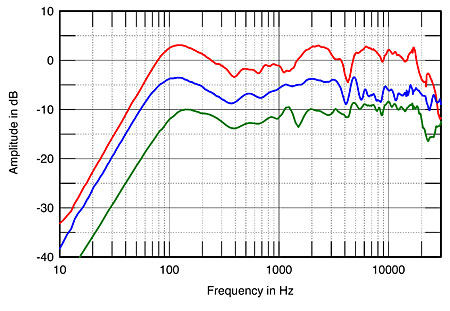
Stirling crossover response:
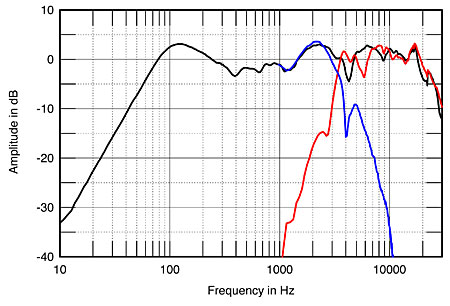
It would seem that an elevated 2kHz bump would give extreme presence.
The Stereophile measurements look a lot lumpier than the above reference response which I got from the German website on DIY shootout of LS3/5A.
Hifi-Selbstbau - LS3/5a Battle des DIY-HiFi-Forums bei Blue Planet Acoustic

Here is mine again for easy comparison. No doubt a lot more tweaking can move things around a bit, but for my particular woofer, I sort of like the effect of the asymmetric crossover that gives a nice close to a right triangle step response.
It is interesting to see that the Stereophile measured step response looks almost exactly like mine with a negative sharp overshoot followed by one postive sharp peak closely spaced to the main right triangle:
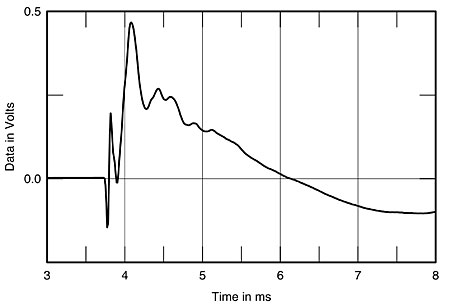
Here is the step response from mine:

Frequency wise - it sounds good to my ears for general listening as a bedroom speaker. It would be much easier to clone the response in DSP if one wanted to do that. But having to do it with two drivers i happened to have on hand and with crossover parts I also happened to have on hand was fun. Nothing was ordered or bought especially for this experiment.
BBC LS3/5a loudspeaker Stirling Measurements | Stereophile.com

Stirling crossover response:

It would seem that an elevated 2kHz bump would give extreme presence.
The Stereophile measurements look a lot lumpier than the above reference response which I got from the German website on DIY shootout of LS3/5A.
Hifi-Selbstbau - LS3/5a Battle des DIY-HiFi-Forums bei Blue Planet Acoustic
Here is mine again for easy comparison. No doubt a lot more tweaking can move things around a bit, but for my particular woofer, I sort of like the effect of the asymmetric crossover that gives a nice close to a right triangle step response.
It is interesting to see that the Stereophile measured step response looks almost exactly like mine with a negative sharp overshoot followed by one postive sharp peak closely spaced to the main right triangle:

Here is the step response from mine:
Frequency wise - it sounds good to my ears for general listening as a bedroom speaker. It would be much easier to clone the response in DSP if one wanted to do that. But having to do it with two drivers i happened to have on hand and with crossover parts I also happened to have on hand was fun. Nothing was ordered or bought especially for this experiment.
Last edited:
And speaking lof crossovers, the LS3/5A official crossover has 13 components I think. Mine has 6. Does it really need 7 more components to make it more complex and presenting an impedance plot that looks like this (this isn’t particularly what I would call, an easy to drive load):
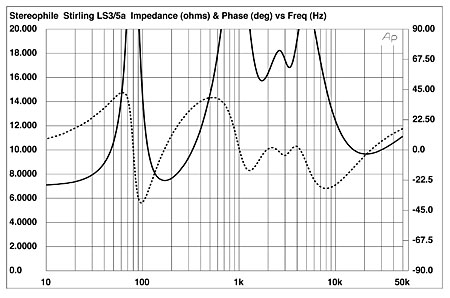
Vs the impedance and fairly smooth electrical phase from mine:


Vs the impedance and fairly smooth electrical phase from mine:
Thanks! Good to see you popped in for a visit.
You wouldn’t happen to have heard an LS3/5A in person have you? Just want to hear what it’s all about and don’t want to spend $2500 to $4000 to do so.
You wouldn’t happen to have heard an LS3/5A in person have you? Just want to hear what it’s all about and don’t want to spend $2500 to $4000 to do so.
Last edited:
Interesting tweeter, like how low it goes, thanks for bringing it to my attention; unfortunately not so low cost here (AUD70), you can get as good or better alternatives for that money
I just went in and remeasured it using my FH9HVX Class AB amp in the early hours of the morning before any household sounds and A/C vent noises etc come on - very quiet ambient. I get about the same response as before and I plotted it with 7-cycle FDW to achieve a similar level of smoothing seen in the Stereophile measurements.
For easy reference, here is the Stereophile measurement of the 1996 Stirling LS3/5A:

SPL measured at 0.5m on tweeter axis with 2.0Vrms. I actually have a -3.8dB (from nominal 83.8dB average SPL) dip at 3.9kHz. My XO is totally different of course...:
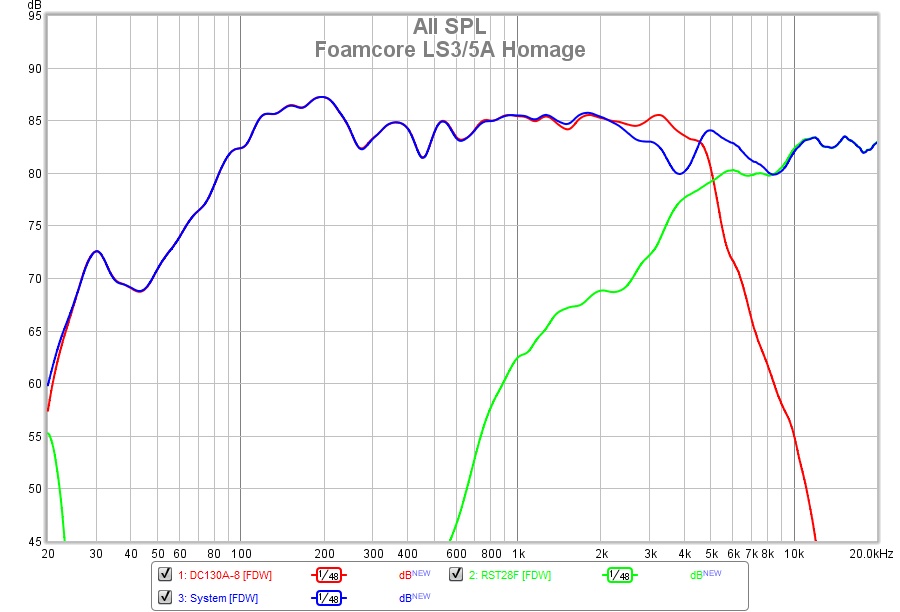
HD vs freq of the woofer (there is a 1.5kHz harmonic distortion bump that is intrinsic to the driver), the rest of the box resonances seem well controlled with the Noico damping, braces, and melamine foam pads. The rise in HD below 100Hz is also intrinsic to any5.25in woofer in a sealed box - even more expensive drivers like the AC130F1 used in Bagby's Continuum exhibits similar distortion:
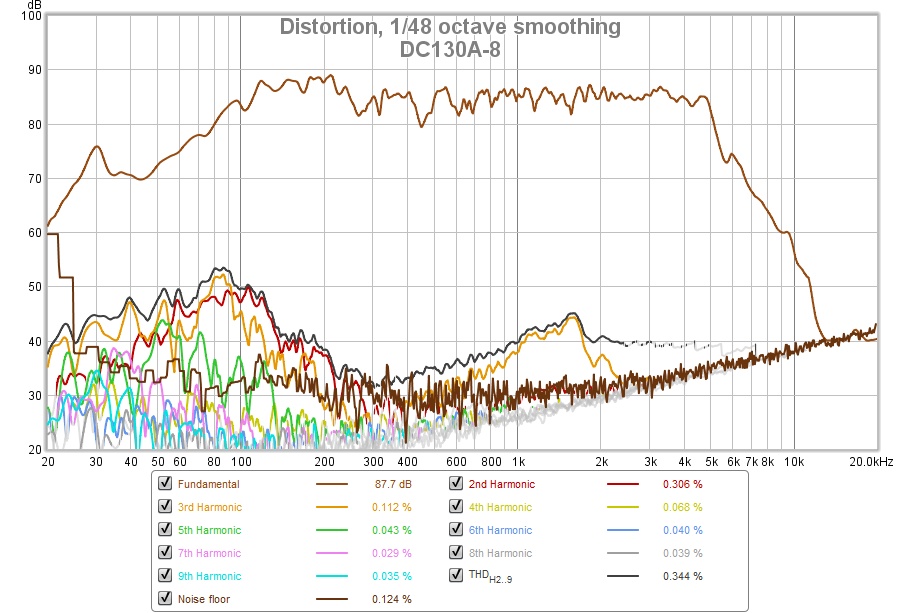
HD vs freq of the tweeter - dang! This tweeter measures very well! Not bad for a $36 unit:
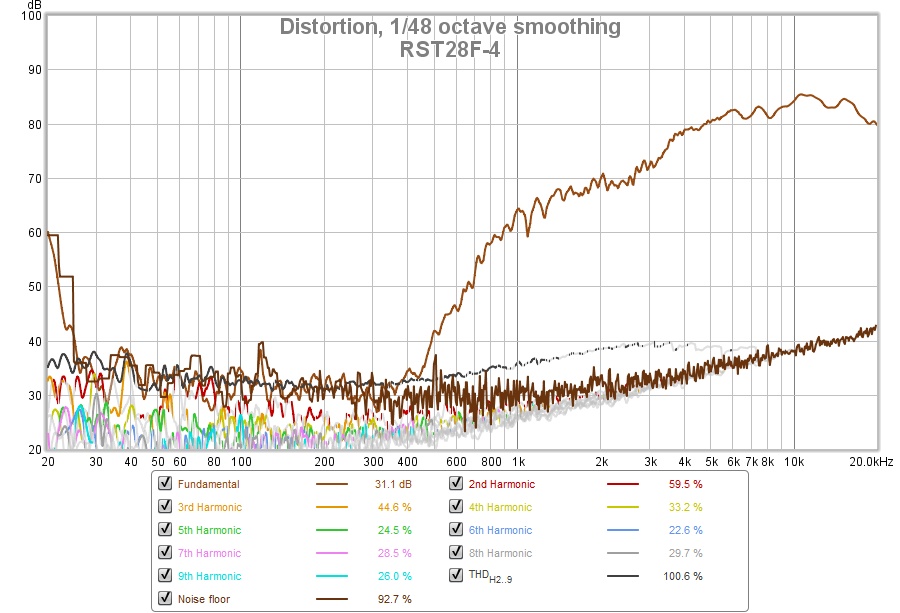
HD vs freq of the Combined System - try not to expect too much below 100Hz:
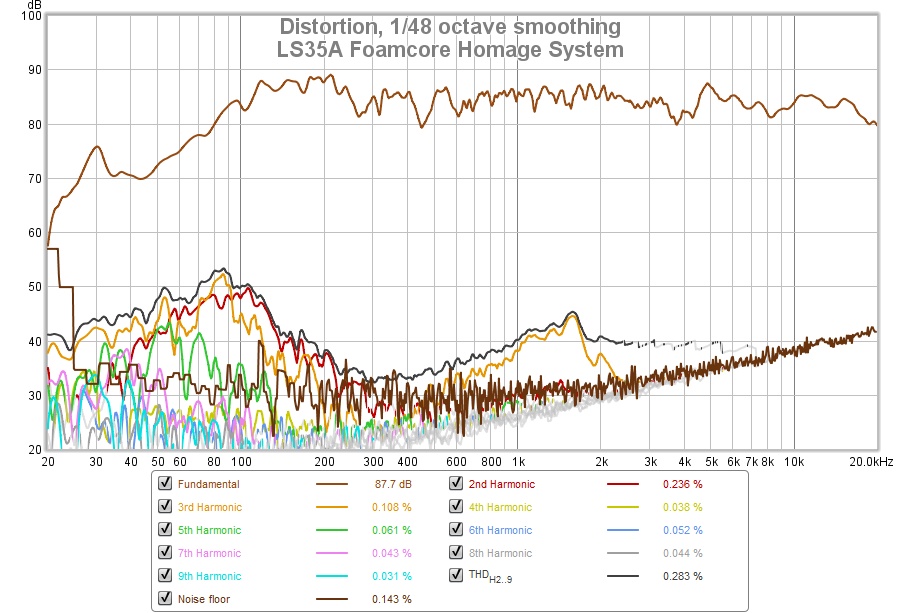
For easy reference, here is the Stereophile measurement of the 1996 Stirling LS3/5A:

SPL measured at 0.5m on tweeter axis with 2.0Vrms. I actually have a -3.8dB (from nominal 83.8dB average SPL) dip at 3.9kHz. My XO is totally different of course...:
HD vs freq of the woofer (there is a 1.5kHz harmonic distortion bump that is intrinsic to the driver), the rest of the box resonances seem well controlled with the Noico damping, braces, and melamine foam pads. The rise in HD below 100Hz is also intrinsic to any5.25in woofer in a sealed box - even more expensive drivers like the AC130F1 used in Bagby's Continuum exhibits similar distortion:
HD vs freq of the tweeter - dang! This tweeter measures very well! Not bad for a $36 unit:
HD vs freq of the Combined System - try not to expect too much below 100Hz:
Attachments
Last edited:
interesting project, did you have sound clip for this build?
Here you go...
Recorded on mono speaker (left channel only) using Zoom H1n in MP3 format at 192kbit/s (for reasons of file size on DIYA servers). Unzip file to get MP3 file as ZIP files are native to DIYA list of permissible uploads.
I have clips from Beyonce, Fleetwood Mac, Tracy Chapman, and Diana Krall.
Enjoy and let me know what you think.
Attachments
Here you go...
Recorded on mono speaker (left channel only) using Zoom H1n in MP3 format at 192kbit/s (for reasons of file size on DIYA servers). Unzip file to get MP3 file as ZIP files are native to DIYA list of permissible uploads.
I have clips from Beyonce, Fleetwood Mac, Tracy Chapman, and Diana Krall.
Enjoy and let me know what you think.
probably you have to look at opus audio format that way much better in lower bit rate than mp3.
I’ll have to look at that but doesn’t seem quite mainstream enough whereas if folks click on and .mp3 file with this extension - it plays music on 99% of all PC/Macs/Linux/phones.
I just checked Audacity does not have it as a standard codec yet - I would need to go find it and install it. Another obstacle to getting the clip out there for people to hear.
If you want a 24bit 96kHz WAV recording - I can get it to you privately. Send me a PM if interested. I don’t think it’s necessary to hear what a basic frequency response voicing sounds like.
I just checked Audacity does not have it as a standard codec yet - I would need to go find it and install it. Another obstacle to getting the clip out there for people to hear.
If you want a 24bit 96kHz WAV recording - I can get it to you privately. Send me a PM if interested. I don’t think it’s necessary to hear what a basic frequency response voicing sounds like.
no worries
it's not mainstream on offline player, but soundcloud and youtube already implement that couple years back also in whatsapp if you made voice note, simple things to play is drag and drop on your browser 😎
just an idea we didn't focus for this things, because on 128kbps bit rate that already hard to heard difference with mp3 320kbps (at least for me).
anyway I listen clip 10F/8424 & RS225-8 FAST / WAW Ref Monitor have better low and mid but high this one seems more details.
it's not mainstream on offline player, but soundcloud and youtube already implement that couple years back also in whatsapp if you made voice note, simple things to play is drag and drop on your browser 😎
just an idea we didn't focus for this things, because on 128kbps bit rate that already hard to heard difference with mp3 320kbps (at least for me).
anyway I listen clip 10F/8424 & RS225-8 FAST / WAW Ref Monitor have better low and mid but high this one seems more details.
I have listened to the Chartwell LS3/5A. Fantastic driver integration and voice reproduction. Almost electrostatic quality.
No bass, of course. Not what I was after that day.

Leeching a bit of bandwidth fron Stereophile's Stirling review. Proves what I have always said. The LS3/5A was a 90 degree phase Butterworth BW3 design or I'll eat my hat. Secret of its success! 🙂
No bass, of course. Not what I was after that day.

Leeching a bit of bandwidth fron Stereophile's Stirling review. Proves what I have always said. The LS3/5A was a 90 degree phase Butterworth BW3 design or I'll eat my hat. Secret of its success! 🙂
- Home
- Loudspeakers
- Multi-Way
- RST28F and DC130A Foamcore Homage to LS3/5A
